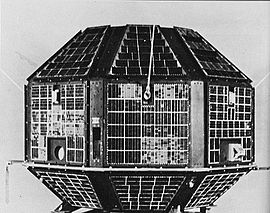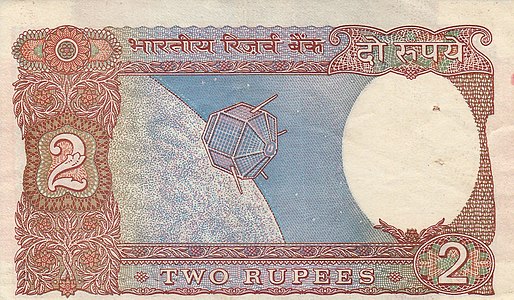cosmos.wikisort.org - Spacecraft
Aryabhata was India's first satellite,[1] named after the famous Indian astronomer.[6] It was launched on 19 April 1975[1] from Kapustin Yar, a Soviet rocket launch and development site in Astrakhan Oblast using a Kosmos-3M launch vehicle. It was built by the ISRO, and launched by the Soviet Union as a part of the Soviet Interkosmos programme which provided access to space for friendly states.
 File photo of Aryabhata, India's first indigenously built satellite. | |
| Mission type | Astrophysics |
|---|---|
| Operator | ISRO |
| COSPAR ID | 1975-033A |
| SATCAT no. | 06755 |
| Spacecraft properties | |
| Launch mass | 360 kilograms (790 lb)[1][2] |
| Power | 46 watts[2] |
| Start of mission | |
| Launch date | 19 April 1975, 07:30 UTC[3] |
| Rocket | Kosmos-3M[4] |
| Launch site | Kapustin Yar 107/2 |
| End of mission | |
| Last contact | March 1981[2] |
| Decay date | 10 February 1992[2] |
| Orbital parameters | |
| Reference system | Geocentric |
| Regime | Low Earth |
| Perigee altitude | 563 kilometres (350 mi)[2] |
| Apogee altitude | 619 kilometres (385 mi)[2] |
| Inclination | 50.7 degrees[2] |
| Period | 96.46 minutes |
| Epoch | 19 May 1975[5] |
Launch
It was launched by India on 19 April 1975[1] from Kapustin Yar, a Russian rocket launch and development site in Astrakhan Oblast using a Kosmos-3M launch vehicle. It was built by the Indian Space Research Organisation (ISRO).The launch came from an agreement between India and the Soviet Union directed by UR Rao and signed in 1972. It allowed the USSR to use Indian ports for tracking ships and launching vessels in return for launching various different Indian satellites.[7]
On 19 April 1975, the satellite's 96.46-minute orbit had an apogee of 619 kilometres (385 mi) and a perigee of 563 kilometres (350 mi), at an inclination of 50.7 degrees.[5][2] It was built to conduct experiments in X-ray astronomy, aeronomics, and solar physics. The spacecraft was a 26-sided polyhedron 1.4 metres (4.6 ft) in diameter. All faces (except the top and bottom) were covered with solar cells.[4] A power failure halted experiments after four days and 60 orbits with all signals from the spacecraft lost after five days of the operation.[citation needed] Spacecraft mainframe remained active till March 1981.[2] Due to orbital decay the satellite entered Earth's atmosphere on 10 February 1992.[2]
Legacy
- It was named after the 5th century astronomer and mathematician from India by Aryabhata.[8]
- The satellite's image appeared on the reverse of Indian two rupee banknotes between 1976 and 1997 (Pick catalog).[4]
- 1984 USSR stamp featuring Bhaskara-I, Bhaskara-II and Aryabhata satellites
- Illustration of Aryabhata spacecraft on ₹2 currency bill
See also
- Timeline of artificial satellites and space probes
References
- "Aryabhata" in The New Encyclopædia Britannica. Chicago: Encyclopædia Britannica Inc., 15th edn., 1992, Vol. 1, p. 611.
- "Aryabhata". ISRO.gov.in. Archived from the original on 15 August 2018. Retrieved 31 August 2019.
- McDowell, Jonathan. "Launch Log". Jonathan's Space Page. Retrieved 22 January 2014.
- "Aryabhata". URSC.gov.in. Retrieved 31 August 2019.
- McDowell, Jonathan. "Satellite Catalog". Jonathan's Space Page. Retrieved 22 January 2014.
- "Aryabhata - The first indigenously built satellite".
- Harvey, Brian (2000). The Japanese and Indian space programmes : two roads into space. London [u.a.]: Springer [u.a.] p. 133. ISBN 1-85233-199-2.
- Harvey, Brian (2000). The Japanese and Indian Space Programmes: Two Roads into Space. London: Springer. p. 134. ISBN 1-85233-199-2.
External links
- Aryabhata-1 Official ISRO Website Archived 15 August 2018 at the Wayback Machine
- NASA HEASARC Page.
- Astronautix Page
- India in Space Page
- NSSDC Master Catalog Search
На других языках
[de] Aryabhata (Satellit)
Aryabhata war der erste indische Erdsatellit. Er wurde nach dem bedeutenden indischer Mathematiker und Astronom Aryabhata benannt und am 19. April 1975 mit der sowjetischen Trägerrakete Kosmos 3M gestartet. Der Satellit untersuchte die stellare und solare Röntgenstrahlung, die Gamma- und Neutronenstrahlung der Sonne und die Teilchenstrahlung in der Ionosphäre.- [en] Aryabhata (satellite)
[ru] Ариабхата (спутник)
Ариабхата (хинди आर्यभट्ट) — первый индийский искусственный спутник Земли[3]. Был запущен в Советском Союзе 19 апреля 1975 года ракетой-носителем Космос-3М (проект Интеркосмос) с космодрома Капустин Яр. Спутник был назван в честь великого индийского астронома Ариабхаты[4]. В русскоязычных советских документах спутник назывался «Ариабата», например, в книге Владимира Губарева[5].Другой контент может иметь иную лицензию. Перед использованием материалов сайта WikiSort.org внимательно изучите правила лицензирования конкретных элементов наполнения сайта.
WikiSort.org - проект по пересортировке и дополнению контента Википедии



